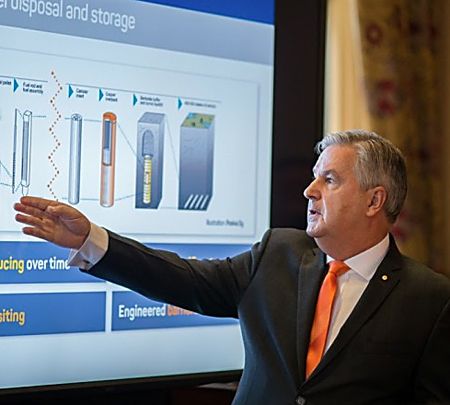Nuke dump would raise a third of state's revenue
15 February 2016
 By ERWIN CHLANDA
By ERWIN CHLANDA
A nuclear dump in South Australia would bring “substantial economic benefits, including annual revenue to the state of $5.6 billion on average for the first 30 years of operation.
“That would equate to additional revenue of about $3300 per person per year and is equivalent to approximately 34 per cent of [the] current state government revenue of $16 billion a year.”
This is reported this morning in the Adelaide-based online newspaper InDaily as the Federal Department of Industry, Innovation and Science is briefing Alice Springs journalists about a site 75 kms south of the town, one of six potential sites “volunteered by landowners, and which met basic geological, climate and other criteria.”
A town hall style meeting will be held by the department at 6pm tomorrow in the Andy McNeill room.
Three sites for a nuclear dump – official name National Radioactive Waste Management Facility – have been put forward in South Australia.
InDaily is reporting the provisional findings of Royal Commissioner Kevin Scarce (photo by InDaily) who, in his report released today, said there would be an additional $2.1 billion benefit for each year of the 43 years [after the first 30], with a high-level storage facility potentially operational in the late 2020s.”
He is referring to “storage and disposal of used nuclear fuel” meeting “a global need” whereas the discussion in Alice Springs has centered on domestic waste.
InDaily reports Commissioner Scarce outlined a plan for a “State Wealth Fund” of $445 billion, which could grow at “more than $6 billion a year for more than 70 years”.
The Federal Government, for its low to intermediate level storage facility, received 25 “eligible nominations” of sites around Australia, including three in the NT (two in the Top End).
Of these six sites were selected “for further public comment”: Sallys Flat – Hill End (NSW); Hale (NT); Cortlinye on the Eyre Peninsula (SA); Pinkawillinie (SA), Barndioota (SA) and Oman Ama Gore (Queensland).



A nuclear dump in South Australia would bring “substantial economic benefits, including annual revenue to the state of $5.6 billion on average for the first 30 years of operation.”
Change the state to the Northern Territory and the revenue will more than double the NT’s annual budget for the next 30 years.
With good policy … not wasteful policies … imagine what that will mean for the Territory.
Think about the progress in the first 10 years of self-government, and the 6% growth rate that the Territory enjoyed. It can all happen again.
The science is safe. Nuclear waste is being stored in a shed, albeit a bloody large shed, in the suburbs of Sydney and in most of the public hospitals in each capital city, including Darwin.
Richard, if it is safe why cannot the wastes stay were they are? Running out of space? NSW has a lot of bush-land.
Yes, great, and the stuff is only toxic several thousand years so a thirty thousand+ year plan is needed not just thirty year plan.
And there have been many problems in Europe. They have no where safe to store their waste. Germany at present is having huge problems with their supposedly safe storage facility that is threatening to poison their groundwater and leach to the surface, causing enormous insurmountable problems.
Some basic maths and commonsense will show you you it is not cheap energy when you have to look after the waste for tens of thousands of years and it is so obviously not clean energy.
Look at how expensive it is to just decommission an old power station. This stuff is just ridiculously dangerous and for an extreme amount of time.
@ Comments: “Much of Europe and the UK are nuclear powered and there have been no problems.”
So Chernobyl wasn’t a problem?
@ Comments: Google Nuclear accidents / incidents and you will realise that there is no truth in your comment.
Worldwide, many nuclear accidents have occurred since the Chernobyl disaster in 1986. Yes, two thirds of these mishaps occurred in the US, but the French Atomic Energy Commission (CEA) has concluded that technical innovation cannot eliminate the risk of human errors in nuclear plant operation.
http://www.theguardian.com/news/datablog/2011/mar/14/nuclear-power-plant-accidents-list-rank
There is also the probability of incidents in transportation of wastes https://www.nirs.org/radwaste/hlwtransport/accidentshistorybrochure.pdf
@ 5: What they propose to extend to is not being housed in a “bloody big shed in Sydney”.
The Australian government has an agreement to receive returns of spent fuel rods from France, UK and now is also musing on storing waste from the continent as some of their stowage is unstable.
And how much of that pittance is going to be needed to keep the stuff safe for the next 250,000 years or so?
“Radium is a most stable isotope, radium-226, has a half-life of about 1600 years.”
There is nothing good about this deal for the Australian people. Figure out better ways to raise revenue that doesn’t cost the earth!